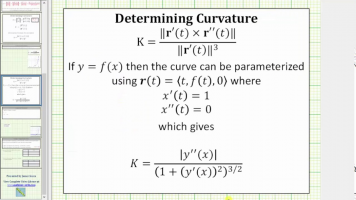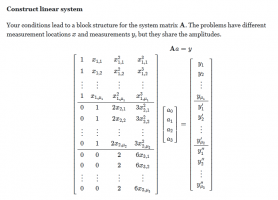You are using an out of date browser. It may not display this or other websites correctly.
You should upgrade or use an alternative browser.
You should upgrade or use an alternative browser.
Curve fitting by curvature
- Thread starter MarkRaz2
- Start date
BeachBanana
Senior Member
- Joined
- Nov 19, 2021
- Messages
- 2,281
The system the book is describing is known as Ordinary Least Square (OLS), more commonly known as Multiple Linear Regression (MLR).
[math]\hat{y}=X\beta+\epsilon[/math]
As the name suggests, the OLS seeks the least square. In other words, minimize the residual error [imath]\epsilon[/imath] of the curve, so it doesn't take the curvature into account.
However, you can compare the fitted and the known curvature simply by looking at their ratios. If it's close to 1, it indicates a good fit.
[math]\hat{y}=X\beta+\epsilon[/math]
As the name suggests, the OLS seeks the least square. In other words, minimize the residual error [imath]\epsilon[/imath] of the curve, so it doesn't take the curvature into account.
However, you can compare the fitted and the known curvature simply by looking at their ratios. If it's close to 1, it indicates a good fit.
blamocur
Elite Member
- Joined
- Oct 30, 2021
- Messages
- 3,223
Do you mean you have curvatures instead of second derivatives or in addition to them?Hi, I found this example below on how to fit a curve by points and derivatives. Is it possible to something similar if If I have some points and curvature k? or if I know the osculating circle? y/n
thanks in advance
View attachment 33107
View attachment 33106
View attachment 33108
Since curvature can be expressed through the first two derivatives you can, conversely, express the second derivatives through the first one and the curvature and thus reduce the problem to the one you've posted.
Hi thanks, I am trying to find "g2" continuity:Do you mean you have curvatures instead of second derivatives or in addition to them?
Since curvature can be expressed through the first two derivatives you can, conversely, express the second derivatives through the first one and the curvature and thus reduce the problem to the one you've posted.

according to this http://www.viewmold.com/ug_html_files/modeling/apx_continuity.html
it states:
"G1 implies that the tangent vectors are equal in direction, but not magnitude. G2 implies the curvature is the same, but the second derivatives are not."
So I guess I'm asking if you can fit 2 polynomials using least squares based on their curvature ?? in addition to 1st and second. Since as you know you need 1st and second to find curvature.

thanks appreciate it
The system the book is describing is known as Ordinary Least Square (OLS), more commonly known as Multiple Linear Regression (MLR).
[math]\hat{y}=X\beta+\epsilon[/math]
As the name suggests, the OLS seeks the least square. In other words, minimize the residual error [imath]\epsilon[/imath] of the curve, so it doesn't take the curvature into account.
However, you can compare the fitted and the known curvature simply by looking at their ratios. If it's close to 1, it indicates a good fit.
thanks for the reply, what do you mean by "ratios"
thanks
BeachBanana
Senior Member
- Joined
- Nov 19, 2021
- Messages
- 2,281
Suppose [imath]K[/imath] is the known curvature, and [imath]K'[/imath] is the fitted curvature.Divide one by the other i.e. their ratio: [imath]\frac{K}{K'}[/imath].thanks for the reply, what do you mean by "ratios"
thanks
blamocur
Elite Member
- Joined
- Oct 30, 2021
- Messages
- 3,223
Just realized that my previous post is not really correct because in this thread the derivatives are given in different points, i.e. [imath]x_{2,i}[/imath] for the 1st and [imath]x_{3,j}[/imath] for the second.Do you mean you have curvatures instead of second derivatives or in addition to them?
Since curvature can be expressed through the first two derivatives you can, conversely, express the second derivatives through the first one and the curvature and thus reduce the problem to the one you've posted.
To make sure I understand the problem you are trying to solve: you are given 4 sets of [imath]x[/imath]'s, one for which the values are defined, another with defined first derivatives, then the set with defined second derivatives and the fourth set for which curvatures are defined. And you need to find a polynomial (3rd degree? 4th degree?) which minimizes sum of squared errors. Is this correct?



